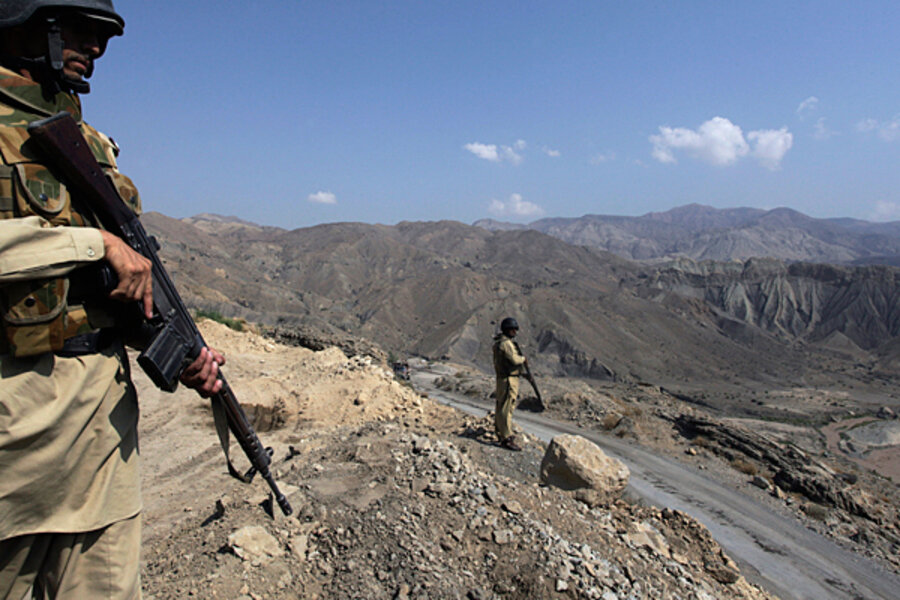US drone attacks bombard Haqqani network in Pakistan
Loading...
• A daily summary of global reports on security issues.
Call it the drone surge: in a continuing, punishing wave of at least a dozen attacks since the beginning of September, unmanned US Predator drones have reportedly killed some 75 alleged militants in areas of Pakistan bordering Afghanistan, according to Al Jazeera.
The latest attack, on Wednesday, killed at least 14 suspected militants in Pakistan’s North Waziristan agency, part of the semiautonomous Federally Administered Tribal Areas (FATA). It was the third such attack within 24 hours, according to unnamed officials cited by the Arab-language news agency.
Taken together, these September strikes would constitute the single largest bombardment unleashed by unmanned drones since the US military initiated the controversial program some six years ago, according to The Guardian. They would bring to 70 the total number of strikes launched this year, a new record. (The Long War Journal charts US drone strikes since 2004.)
The attacks appeared to target the militant network of Jalaluddin Haqqani, a one-time Pakistan ally whom the Pakistani government has been reluctant to take on. The New York Times reported in June that Pakistan's military was pushing to incorporate the network into a postwar Afghanistan settlement.
Is the firepower working? And is it worth the public fallout that inevitably follows from such attacks? As the US turns up the volume on the drone program, those two questions are getting more attention in Washington and Islamabad.
US officials, who never officially acknowledge the program’s existence, have refused to comment on the reasons for the recent September surge. Nonetheless, the attacks follow a steady pattern exhibited this year of the US military pounding positions held by the Haqqani network.
The Haqqani network, which is known to support cross-border operations that attack US-led troops in Afghanistan, has been in the crosshairs of the US military for some time, The Christian Science Monitor has reported – particularly since January, when a Jordanian double-agent, using a suicide bomb, assassinated seven CIA officers in Khost, Afghanistan. US officials blamed the Haqqani network for helping to plan that attack. In retaliation, the US military launched a record number of drone strikes against the group, according to the Reuters blog Afghan Journal.
This week attacks continued. On Tuesday, at least 15 people were killed in two separate attacks that sent residents into a panic in Darga Mandi, a village outside the capital of North Waziristan, reported Al Jazeera. Villagers were just getting over that fright when a fleet of drones again buzzed the town shortly before dawn on Wednesday. According to eye-witness accounts cited by Al Jazeera, several drones fired at least 12 missiles at a compound belonging to a man identified as Bacha Khan, who rented the buildings to members of the Haqqani group.
For US officials, such attacks are the best bet the US has to strike a remote and determined enemy. The drone surge, they say, is part of a “hammer and anvil” operation: as drones pound the Haqqani network and its sympathizers from the air on the Pakistani side of the border, US special forces are targeting the groups fighters on the Afghan side through night raids and other operations, according to the Associated Press.
US officials insist that the plan is working, though they admit that the drone attacks have not stopped the Haqqani network. Rather, the group continues to draw new recruits to fill in for the fallen, the Associated Press reports. The only advantage, they add, is that the new recruits may be less competent than the men they replace.
Overall, however, US officials say that the drone program has been a success. Earlier this year, CIA director Leon Panetta insisted that drones had left Al Qaeda’s leadership weakened and scrambling. The Wall Street Journal recently reported that the US is even considering expanding the drone program to Yemen, where Al Qaeda appears to be active.
But the inevitable civilian deaths they cause generates support for militants. Critics of the program argue that civilian casualties are high. A report by Peter Bergen and Katherine Tiedemann of the New America Foundation, a Washington-based think tank, indicated that of more than 1,000 people killed in drone strikes since 2004, about 30 percent were civilians.





